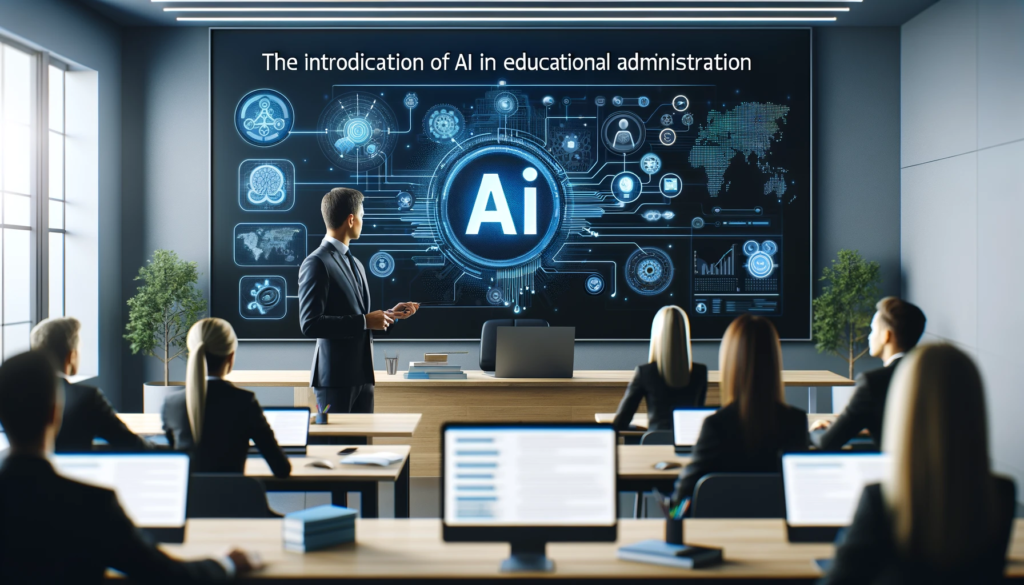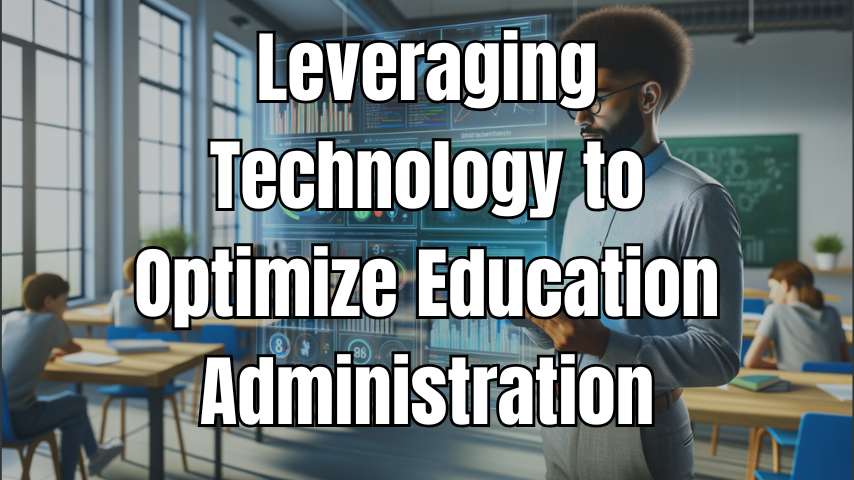The world we are living in is becoming more technological with each passing day. New innovations come up that make alterations to the various sectors that depend upon digital solutions, corporate environments, the health sector, and especially the education sector. Digital documentation technology, for instance, has become indispensable for schools, colleges, and universities in the education sector as they face new challenges in education administration.
This is not a trend but a new course of adaptation aimed at smooth operation, effective communication, and optimal resource utilization. Read till the end to know how education administrators are leveraging technology to ease their everyday tasks.
The Need for Technology in Education Administration

Educational institutions with multiple administrative tasks such as admissions and enrollment, payroll management, facilities, among many others. These processes were handled manually by any manager which led to inefficiencies, miscommunications, and increased costs. However, The pandemic emphasized the reality that there is a huge need to have robust digital infrastructures. Nowhere is this seen more clearly than in the way schools used technology before the crisis. The ones that had already embraced it and had the infrastructure in place found it relatively easier to pivot to online learning, showing that smartly positioned institutions are better at weathering crises.
Fundamentally, education has to be adapted with strategies that ensure administrative systems evolve with it. Leveraging technology is not just keeping pace with modern trends; it’s preparing institutions for a future ever increasingly dependent on digital solutions.
Benefits of Technology in Education Administration

Integrating technology into education administration has several benefits. Below are some of the most compelling reasons stated:
Increased Efficiency and Time Savings
One of the most significant advantages of using technology in the education sector is the ability to process routine tasks for the administrators. Imagine an administrative staff member who was spared no extra hours processing admissions or keeping tabs on what students were assigned to their classes. The digital systems applied here ensure that these tasks would be dealt with efficiently and accurately, meaning those staff members might concentrate on much more impactful work: for instance, talking with students or improving programs.
Moreover, Technology also encourages positive communication. Automated messaging systems automatically communicate updates from the learning institution to students and parents. In the event of timely information transmission, delays are no longer a problem for anyone; all concerned parties are guaranteed instant updates.
Enhanced Data Management and Reporting
In an age where data-driven decision-making is vital, educational institutions can reap significant rewards from technology’s ability to manage and analyze information. Modern administrative systems are fitted with strong analytical capacities for data and will enable institutions to track metrics such as student performance and financial health with relative ease.
Those reports which, previously, would take hours to produce now take but a few minutes. Beyond serving all regulatory needs, data is smoothly managed so that the institution’s administrators can indeed make wise strategic planning decisions. Data-informed decision-making helps to foster a culture of accountability and transparency within the educational institution.
Better resource allocation
Besides, Enhancing Data management is also a better resource for Allocations. It’s one of the cornerstones of effective educational administration, and technology has a big role in this. In this respect, with digital tools, the institutions can track the budgets of managed physical assets, and optimize the use of classrooms and facilities.
For example, advanced room and resource allocation through scheduling software can automatically assign rooms and resources based on the availability and the requirements of collision-free usage and optimal utilization of the spaces. This will directly maximize the facility use while ensuring that less time and labor is being wasted.
Enhanced Student Experience
The ultimate goal of any academic institute is to provide an extraordinary experience to students. Technology helps make the administration process user-friendly. Students can enroll in classes, check their grades, and communicate with their advisors or counselors without having to go through a lot of paperwork or long queues.
Furthermore, by leveraging technology, schools may detect at-risk students using data analytics. With prompt intervention and support, educators may give tailored help, resulting in better outcomes for all children. When children feel encouraged and involved, they are more likely to excel academically and personally.
Key Digital Tools Optimizing Education Administration
As we explore specific areas where technology enhances the administration of educational institutions, it becomes clear that various tools cater to distinct needs. Here are some of the most common and impactful tools being used today:
Student Information Systems (SIS)
The SIS systems have greatly improved the way student information is managed in modern educational administration. Administrators can easily track important data such as attendance, grades, and more.
Further, SIS systems enable secure communication between students, parents, and teachers. In case of knowing the student’s progress and updates from the institution, a more coherent learning environment is developed. Furthermore, integrating SIS systems with others such as LMS provides comprehensive insights into the educational journey of every student.
Learning Management Systems (LMS)
LMSs are generally viewed as useful tools for instructors, but for administrators, it brings benefits to the fore. The first of these is the ease with which course management can be performed as educators have a single platform where they can upload resources, check on students’ progress, and evaluate assessments.
For administrators, LMS platforms give them valuable insights into what transpires in the classroom during a given period. Such valuable information as teaching effectiveness, class participation, and percentage completion of courses is essential for the assessment of overall performance by instructors and the curriculum. This leads to informed decisions about improvements and alterations.
Human Resource and Payroll Systems
Other than LMS and SIS, the other equally important is the management of human resources, which goes hand in hand with the management of students. Payroll and HR management systems automate many administrative tasks relating to employee management, including tracking hours, leave requests, and payments.
These systems simplify recruitment and onboarding by streamlining application tracking, interview schedules, and document management. This not only helps administrators manage their workforce more effectively but also removes bottlenecks. It ensures smooth communication with all employees.
Financial Management Software
For any educational administration, budgeting and financial planning are must-tools. This financial management software assists institutes in keeping track of budgets, expenditures, and quickly compiling reports. Thereby, enhanced transparency allows administrators to pinpoint areas where resources are outpacing one another-similarly, where they are not utilized effectively.
In addition, financial management platforms most offer forecasting tools, whereby educational institutions can project future needs relative to current trends. Such foresight is necessary for sustainable financial planning.
Online Registration and Admission System
The old days of throngs of paperwork for admissions and registrations are gone.Internet-based registration and admissions platforms have changed the face of enrollment, making it possible to complete every aspect, from form submission to fee payment, totally online. This is even easier using editable PDF forms whereby students can simply input their information, make all the necessary amendments, and submit their applications without the headache of printing out or scanning documents.
This shift further makes the experience more simple for applicants and administrators. Automated systems smooth verification processes and smooth communication to create an efficient and more user-friendly admission experience.
Implementing Technology in Educational Administration: Problems Encountered

The incentives of using technology in educational administration are numerous, but institutions are yet thwarted by various obstacles. It is the understanding of these challenges that makes successful implementation possible.
Installation Cost
Firstly, the implementation of new technologies is highly capital intensive. Even though most of the time the long-term benefits supersede the investment made initially. In fact, acquiring, installing, and maintaining all such new technologies requires financial input and planning of educational institutions for smooth transition.
Training and Adaptation
Secondly, the latest technologies are only effective when operated by effective human beings. Therefore, proper training for the people is one of the major issues involved while introducing new administrative systems in place. Institutions have to spend much more time and resources on complete training packages to help employees with the full utilization of capacity of a new system.
Data Security and Privacy Concerns
Last but not the least, the growing level of dependency by institutions on digital platforms for sensitive information relating to students and employees necessitates keen vigilance and therefore effective security measures that would protect the same. The threats in the cybersecurity arena rise each day. Therefore, the institutions have to invest in becoming relevant with adequate security measures to prevent unwanted breaches as well as access to data.
Along with this, data protection rules must be followed. For example, the Family Educational Rights and Privacy Act (FERPA) in the United States. The institution must ensure its systems protect the privacy of both students and staff. Additionally, they must comply with any relevant laws.
The Future of Technology Education Sector
To make sure education will keep on growing, technology will be an ever-greater enabler to optimize administration. Digital tools help learners focus on improving processes and making better use of resources. This enhances communication and supports informed decision-making. These are just a few examples of how technology can improve efficiency and performance in educational institutions.
Institutions need to think ahead about their implementation strategy, how they’ll handle issues that may come up, and train their staff to genuinely take advantage of the power of technology. This way, institutions do not just keep up with change but thrive in an ever-shifting education landscape.
To Sum it All
With the right digital solutions, learning institutions can keep providing great experiences for students, staff, and the broader educational community. As we move forward into a digital future, we must remember that behind each technological leap is a vision. This vision aims to transform learning and prepare the next generation for the digital world.







